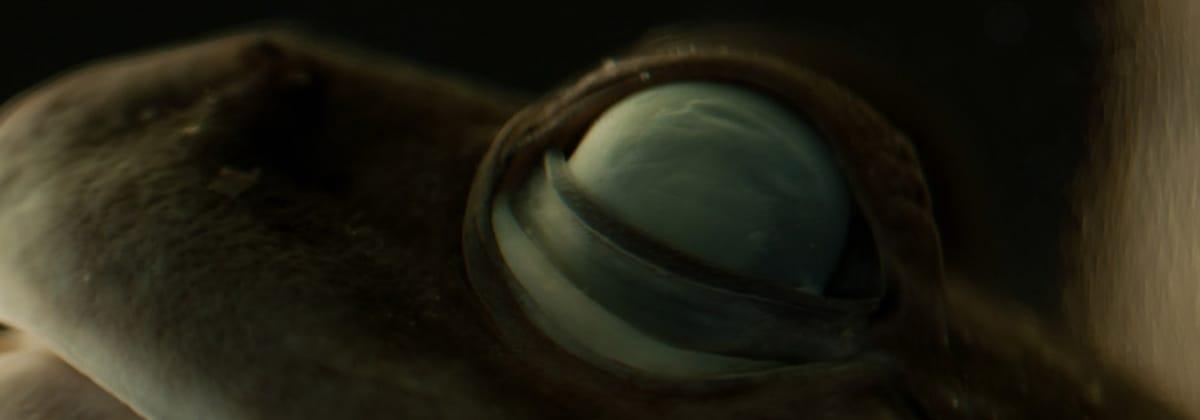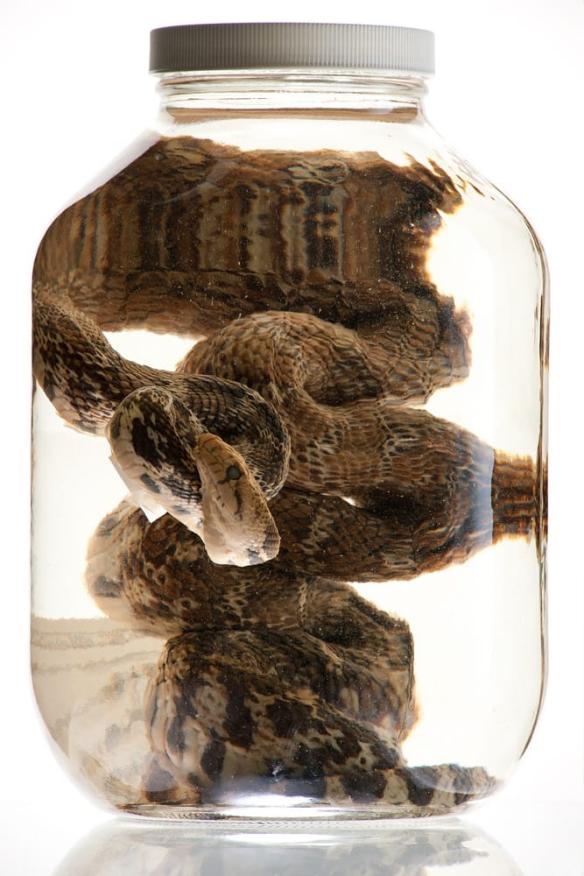
Modernization
Learn more about government’s intention to modernize the museum to protect our historic holdings and provide better access to our collections.


Most people are familiar with the game animals in British Columbia, but not with the vast majority of BC’s marine, freshwater, and terrestrial vertebrates that are not exploited for human use. Non-game organisms form the foundation for ecological communities, and these organisms cannot be ignored if we hope to understand population dynamics in British Columbia. The Royal BC Museum’s collection contains over 101,861 vertebrate specimens, in a wide range of life-history stages from eggs, eggshells, preserved embryos, tadpoles and newly hatched or neonate animals to fully adult individuals. About 34 amphibian and 31 reptile taxa are represented in this collection, with more added every time researchers get out to survey new areas.
Most amphibians and reptiles are housed in jars ranging from 125 ml up to 2 litres volume; large wet specimens such as sea turtles and snapping turtles are housed in vats. The collection also includes a limited amount of skeletal material. Each jar in the collection may only house one specimen, or in other cases, the jar may be packed with a number of specimens caught at a particular place and time. Each specimen, whether in a jar or a plastic Durphy box, has a label with some collection data and catalogue number, and specimens are ordered in the collection according to a rough pattern of evolutionary relationships.
This collection contains a type specimen of the Columbian tailed frog, a species recognized based on genetic and geographic data. Type specimens are the best examples of a species at the time a particular species was described. Better specimens may be found years later, but the type specimen designation stays with the original material used to describe a species. There are provisions for designating new types specimens if the originals are lost, but this is the exception rather than common practice.
Type specimens are held in separate cabinets away from the main part of the research material. Type specimens do not go on loan to other institutions, and therefore, researchers must come here to examine these high-priority items.
Most vertebrates in the collection are from British Columbia, but a small portion of the collection comes from outside our borders, and serve as examples of organisms that may arrive here in the future (e.g., western fence lizard) or are examples of closely related organisms for comparison. There are also several exotic species in this collection in order to document the continued presence of species introduced by humans from the pet trade or as accidental introductions. The collection does contain a small proportion of other exotic organisms that today would be rejected since they are not representative of British Columbia (e.g., reticulated python, common boa, western fox snake).
The vertebrate collection likely was the first to be established by Jack Fannin when the museum was created to stem the flow of artifacts out of province. Our oldest herpetile specimen is a European adder from 1834. This specimen is an exception to the modern collection plan focused on British Columbia’s nature history. Dozens of new specimens are added each year, including sea turtles and the eggs of the exotic red-eared slider recently discovered near Elk/Beaver Lake. The collection grows from research specimens, donations, and from specimens transferred from the Department of Fisheries and Oceans, Ministry of Transport, Ministry of Environment, regional Natural Resources Officers, and a wide range of other sources.
Fortunately, there is no backlog to the herpetology collection.

The amphibian and reptile collection is fairly evenly split among species. Based on the distribution of amphibians and reptiles, the collection, by necessity, is biased towards the southern end of the province. The first record of the Olive Ridley Sea Turtle in British Columbia is preserved at the museum, representing a significant addition to the collection. This collection also recently received a salamander that arrived in BC as a stow-away on produce from California; another example of a stow-away from California is the Yellow Bellied Sea Snake which arrived in BC in the ballast water of HMS Cayuga in the 1950s.
In recent years, the emphasis has shifted to the collection of representative exotic species, including examples of reptiles from the pet trade that have been released in BC. This collection is frequently used by researchers from neighbouring provinces and states and from around the world for a myriad of projects ranging from analyses of ecology, basic anatomy and systematics.
The collection’s greatest limitation is space to cover all major taxonomic groups. We will need additional room for at least another 30 specimens in the next few years. While jars of herpetiles are housed on compact shelving, the collection shares space with the marine and freshwater invertebrates, and the shelves are nearly full with little room for expansion.
As with all vertebrate groups, this collection is focused more towards organisms in the southern end of the province. We have many specimens from southern Vancouver Island, the Fraser River delta and the Okanagan region, and comparatively few from the interior portions of the Fraser drainage, the Yukon drainage and the Mackenzie drainage. The collection also has few specimens from the northern coast and Haida Gwaii (formerly known as the Queen Charlotte Islands). This is primarily due to the expense of accessing these locations.
By necessity, the vertebrates collection is biased towards smaller animals because of space limitations and preparation. The present complement of wet-collection vats is nearly full so we are fortunate that stranded sea turtles are fairly rare occurrences. Regardless, we require more vats and shelf space to allow for collection expansion.
Recent
Our new focus is to more efficiently use space and try to make room for collection expansion within the existing walls of the Fannin Buillding. There has been no concentrated collecting effort for herpetiles, with most specimens arriving either as donations or incidental collections (mainly from roadkill) while out on other research trips. These collections are important to document what species are here today, for reference to any potential changes to the fauna in the near future. Collections have been done in the Similkameen River area, on Vancouver Island, and at a few localities on the north coast during museum survey trips. The Royal BC Museum has had trouble obtaining survey permits and so little collecting has been done in recent years for freshwater and terrestrial species.
Future
Survey permits tend to be difficult to obtain. Continued surveys are required to keep pace with changes in vertebrate populations, detect the presence of new exotics or expansion of the range of exotic species, and keep track of changes to native species in this province—especially species at the lower end of the food chain, which tend to be overlooked. In an environment already heavily impacted by humans, it is difficult to justify collecting when species are already declining compared to historical levels, but we cannot protect what we do not understand, and we cannot understand that which we do not examine. Recovery of roadkill, specimens from Natural Resource Offices and other sources is critical to maintaining a constant flow of specimens into the collection for future research projects because we cannot predict what future researchers will study. Granted, this biases the collection to areas near human activity, but in times of fiscal restraint, this will maintain a flow of specimens at minimal cost.
The collection’s priorities include:
Multi-staff sampling trips every five years will support routine collecting efforts across different regions of BC and help limit temporal as well as geographic gaps in the collection. We also will continue to develop and maintain relationships with outside parties and the general public to ensure a continual flow of specimens and to let people know that the RBCM is still collecting and preserving natural history specimens.
With the increasing popularity of genetics research, the Royal BC Museum receives frequent requests for tissue samples. New −80°C freezers installed in the wet collection in 2011 allow us to increase our relevance to the research community because tissue samples now can be taken and preserved. New specimens (if not already fixed in formalin) will have a tissue sample taken prior to fixation for molecular research, as well as a whole body fixed in formaldehyde or prepared as a skeleton for morphological research.
Government staff, contractors or consultants who collect specimens as reference material and vouchers should send their material to the Royal BC Museum. The museum represents a stable repository for specimens for future verification of identification and research. The museum is also actively soliciting specimens from the general public, even though collecting near urban environments biases the collection to places frequented by humans. However, these specimens are valuable in that they document our impact on the environment. Good quality specimens should be forwarded to the Royal BC Museum as records of mortality in BC.
Since 2008, the vertebrates collection has received 11 lots of amphibians and 16 of reptiles; each lot may contain multiple specimens needing preparation or preservation. Most of these herpetile specimens represent road-kills or exotic species.
Researchers are welcome to examine the collections by contacting the appropriate curator and making arrangements with the collections manager. Please give as much notice as possible. You may contact museum staff by e-mail, letter or phone. We will want to know the expected dates of your visit, the specimens you want to examine, and your equipment needs (e.g., a microscope). Collection access is between 9:00 AM to 4:30 PM, Monday to Friday, unless otherwise arranged with the curator or collection manager. Requests for loans of specimens must go through the collection manager.
